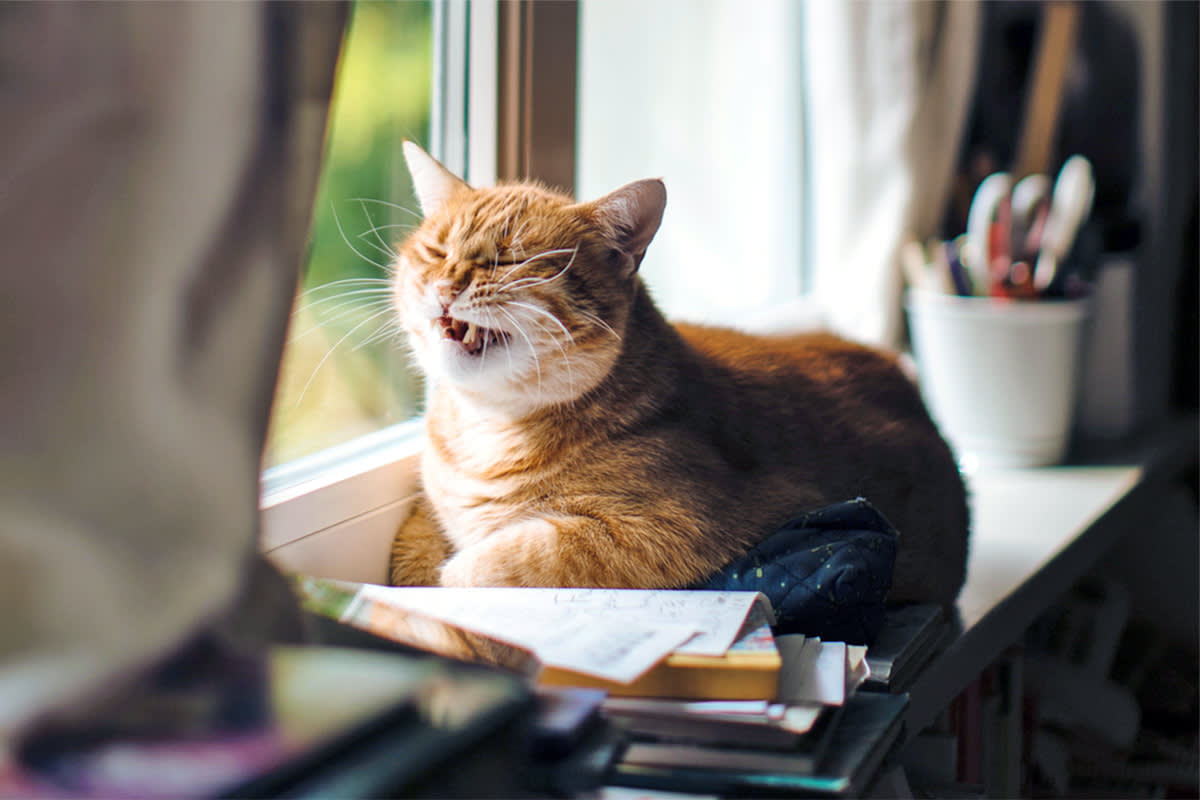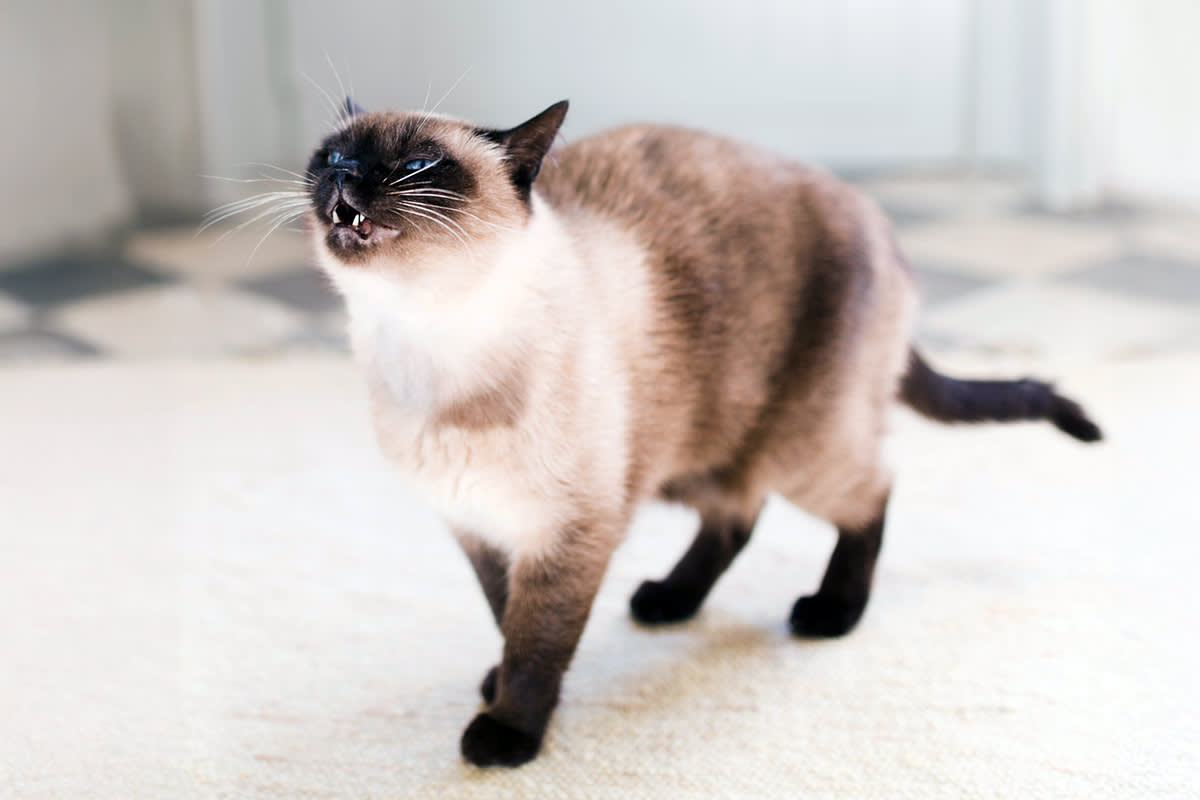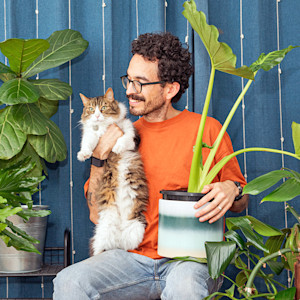Why Does My Cat Make “Stink Face”: Understanding the Flehmen Response
It’s definitely not because you disgust them.

Share Article
In This Article:
What Is the Flehmen Response? How Cats Use It What It Looks Like Biological Process
You may have seen a video like this on social media: One cat is sniffing another cat’s butt, when suddenly they make a funny face (they pull up their lip and show off their whole mouth), as if they’re saying “Dude, you stink!” We humans are likely to find this peculiar behavior amusing and relatable (as a New Yorker, I can say I have definitely made that same face at someone else’s butt-smell on the subway), so you might be surprised to learn what the feline “stink face” actually means, and the reason why cats make it.
First of all, the expression pet parents might callopens in new tab “stink face” actually has a proper scientific name: the flehmen response. This name is derived from the German word opens in new tab “flemmen,” which means “to curl the upper lip.” And it’s not unique to felids (members of the cat family), either. It’s also performed by ungulates (mammals with hooves like horses, sheep, and deer).
And while cat parents may be surprised to find out their pet has something in common with a rhinoceros, the flehmen response presents much the same in all the species that exhibit the behavior. In each of these animals, the top lip curls back to reveal the animal’s front teeth and gums, and it inhales deeply while holding itself still for a few seconds.
They may make the stink face when you’d expect them to, like when they smell pee (or any kind of stinky butt odor), dirty laundry, or another cat’s anal-gland secretions. But it could also happen any time they smell something new or exciting (tell your new S.O. they may be in for a little stink-face action!).
How much do you spend on your pet per year?

But fear not! When they make this face, it doesn’t mean they’re disgusted with you or someone new you bring around — unless they have reason to be. Most likely, they are just experiencing a new smell, and they’re responding to it. In fact, it’s literally a natural bodily response...
What is the flehmen response?
It turns out that when an animal is exhibiting the flehmen response, they’re using a little-known olfactory organ opens in new tab called the vomeronasal organ opens in new tab(VNO), or Jacobson’s organ, which is above the roof of their mouth and just behind their front teeth. All mammals, plus snakes and lizards, have this organ; even humans have some leftover traces of oneopens in new tab, though ours doesn’t work.
You may have already learned that a cat’s sense of smell is much, much stronger than a human’s — supposedly about 14 times stronger, in fact — so it hardly seems fair that cats also have this secret “second nose.” But this organ is a necessary adaptation for cats because it specializes in the detection and analysis of a primary way cats communicate: pheromones.
Detecting pheromones
“We know that cats deposit pheromones from specific scent glands in their body, including ones near the genitals, but [also] their cheeks, their paws — these are always depositing pheromones,” says Mikel Delgadoopens in new tab, a cat behaviorist and senior research scientist at Purdue University. “So, the flehmen response is information gathering — it’s just like looking at something. Their body’s just saying, ‘Hey, there’s pheromones here. Let’s check this out,’ and then it’s processing the information ... All they’re doing is drawing air and moisture into their mouth, so the [pheromone] molecules are coming in and making contact with the roof of the mouth.”
Pheromone detection is a special ability designed to aid cats’ survival in the wild; it helps them do things like avoid another cat’s territory or find a suitable mating partner. But it’s important to domestic cats, too. You may have observed your own cat engaging in the behavior known as “head bunting” or “allorubbing,” where they rub the scent glands in their body (usually their face) on objects, their cat siblings, or their human companions. The scent markings left behind by this process aren’t noticeable to us because they’re pheromonal, but it’s the cat’s way of displaying ownership of their territory or expressing affection.
Detecting chemical signatures
Allorubbing and pheromone release also helps to create a cohesive, unified “group scent” or “colony scent”; it’s how they communicateopens in new tab. “When [cats] live together, they tend to scratch the same things, they tend to rub on the same things, they share litter boxes,” Delgado says. “These are ways that they combine scents to basically establish a group scent, which [the scientific community] believes they identify more strongly with than their individual scent signature.”
How do cats use the flehmen response?
Cats use the “stink face” to pick up on the world around them. So, when it looks like they are disgusted at something, they are really just feeling out their environment.
Mate selection
Male cats commonly assess a female’s urine when they are trying to figure out if she’s ready to mate.
Territorial markings
Yes, your cat will pee to own what is theirs. So, when another cat comes along to sniff out the urine situation, they may get a big whiff of a scent that says, “Back off; this belongs to me.”
Scent information in urine
Cats can also pick up valuable intel about their fellow felines through the smell of their urine. For example, if a cat is anxious, scared, or stressed, another kitty may be able to sniff out that emotion in their pee. It’s like leaving a secret hidden message!
Evaluating safety
Because cats can read emotions from the pheromonal scents they pick up, it’s useful for them to know if they should exercise caution in a specific area. If they smell that a cat who came before them was scared, they are alerted to potential danger and know to be on alert.
What does the flehmen “stink face” look like?
As mentioned above, the flehmen response looks like your cat is snarling. They pull up their lip and pull it back to show their teeth. So, stink face is actually kind of fitting, though it doesn’t at all describe what’s actually going on. They’re not mad at you or anyone else — just taking in the world. Let’s break down the look a little more.
1. Reared head
Your kitty may raise their head like they are on alert. You’ll look for the mouse or fellow feline you think they see, but nothing. They are seemingly vigilant for no reason.
2. Curled upper lip
You’ll also see your cat curl up their upper lip like they smell something disgusting or hate you (one of the two). Again, that’s just the way it looks, not necessarily the way it is.
3. Grimace
They will also look like they are sneering or smirking, maybe even wincing. This just goes along with the curled upper lip.
4. Open mouth
Their mouth will also be open, and you’ll be able to see their little front teeth, especially because they’ve pulled their lips up, revealing everything going on in there.
5. Inhale
They will breathe in as they take in the scents around them, so you may hear them take a big inhale. During the flehmen response, kitties inhale and smell through scent receptors in the roof of their mouths, which is why they look like full-on mouth-breathers when they do their stink face.
The biological process behind the flehmen response
Scent captured through the mouth
Again, cats take in the pheromones around them via the VNO in the roof of their mouth.
Processed by specialized vomeronasal organs
The VNO is located between the roof of the mouth and palate. They are connected to the brain through nerves; once a cat takes in a scent through their VNO, the smell is then scent to their brain so they can process the information contained in that smell.
Sent to sensory areas in the brain
Kitties have many specific parts of their brain that take in information in a certain way, namely the thalamus and the anterior ectosylvian sulcus (AES). The AES has three subregions: the somatosensory SIV25, the auditory FAES26, and the visual AEV27. Once the information is processed by the VNO, it’s sent to these sensory parts of the brain that tell your cat how to feel.
Bottom line: Should we still call it stink face?
While science has been able to nail down some information around cats’ pheromone signaling behaviors and the capabilities of the VNO, much of it still remains unknown, and humans can merely make an educated guess. For example, we don’t yet know if the VNO is also capable of detecting regular, non-pheromonal scents. “We know [the VNO] is specialized for pheromone detection,” says Delgado, but “it’s an open debate as to whether or not they can actually detect other scents with this organ.”
She also points out that referring to the flehmen response as stink face is kind of a misnomer. “I think stink face is maybe not the best word to describe it,” she says. “We’re interpreting their facial expression as unpleasant, but there’s no real reason to think that what they're encountering is unpleasant to them … I think we just make a lot of assumptions that they’re experiencing the world pretty similarly to us — which is a flawed assumption.”
While this is certainly true, it’s still only natural for us to instinctively anthropomorphize our pets. Faced with large gaps of knowledge about how our companions experience and process the world, we’re forced to fill in the blanks with our own human experiences. But the next time you see your cat making “stink face” at something, you’ll know a little bit more about what’s really going on — and perhaps have a new sense of appreciation for your kitty and their fascinating physiology.
References
J;, Verberne G;de Boer. “Chemocommunication among Domestic Cats, Mediated by the Olfactory and Vomeronasal Senses. I. Chemocommunication.” Zeitschrift Fur Tierpsychologie, U.S. National Library of Medicine, pubmed.ncbi.nlm.nih.gov/988693/opens in new tab. Accessed 6 June 2025.
Hart, Benjamin L. “Flehmen Behavior and Vomeronasal Organ Function.” Springer EBooks, 1 Jan. 1983, pp. 87–103, https://doi.org/10.1007/978-1-4757-9652-0_5opens in new tab.
Piedad, Kristine . “Feline Olfaction and the Extraordinary Superpower of Cat Smell.” Felidae Conservation Fund, 22 Jan. 2024, felidaefund.org/news/general/feline-olfaction-and-the-extraordinary-superpower-of-cat-smellopens in new tab.
Vasuki, A.K.Manicka. “Fate and Development of Human Vomeronasal Organ – a Microscopic Fetal Study.” JOURNAL of CLINICAL and DIAGNOSTIC RESEARCH, 2016, https://doi.org/10.7860/jcdr/2016/15930.7373opens in new tab. Accessed 8 Apr. 2020.

Rachel Pick
Rachel Pick is a freelance writer and social media editor who has written for Vice, The Guardian, and SELF. She lives with two cats: Cricket, a genteel lady who is the picture of refinement, modesty, and good manners; and Cowboy, who is an agent of chaos, slapstick comedy, and foul odors. Her work here frequently focuses on cat companionship and cat behavior.

Hilary Weaver
Hilary Weaver is the senior editor at Kinship. She has previously been an editor at The Spruce Pets, ELLE, and New York Magazine. She was a staff writer at Vanity Fair from 2016 to 2019, and her work has been featured in Esquire, Refinery 29, BuzzFeed, Parade, and more. She lives in New York City and New England with her family, which includes two herding pups, Georgie and Charlie.
Related articles
Why Do Cats Sniff Butts?
Hey, there, dude—isn’t that a little personal?
Why Do Cats Tuck Their Paws? The Cat Loaf Explained
It’s not just cute—it can be a sign of something more.
Hot and Cold: Why Do Cats Give Us Such Mixed Signals?
That whole cuddle and then attack scenario, explained.
Why Does Your Cat Smell Bad?
You love them, but oooh, boy, that is unpleasant.
![Woman trying to get her pet cat's attention at home.]()
This Is the Most Effective Way to Get Your Cat’s Attention, Study Says
They can't ignore you forever.
![Man holding cat in lap while surrounded by plants.]()
12 Ways to Tell That Your Cat Is Happy
It’s all in the eyes... and ears and tail. And so much more.







